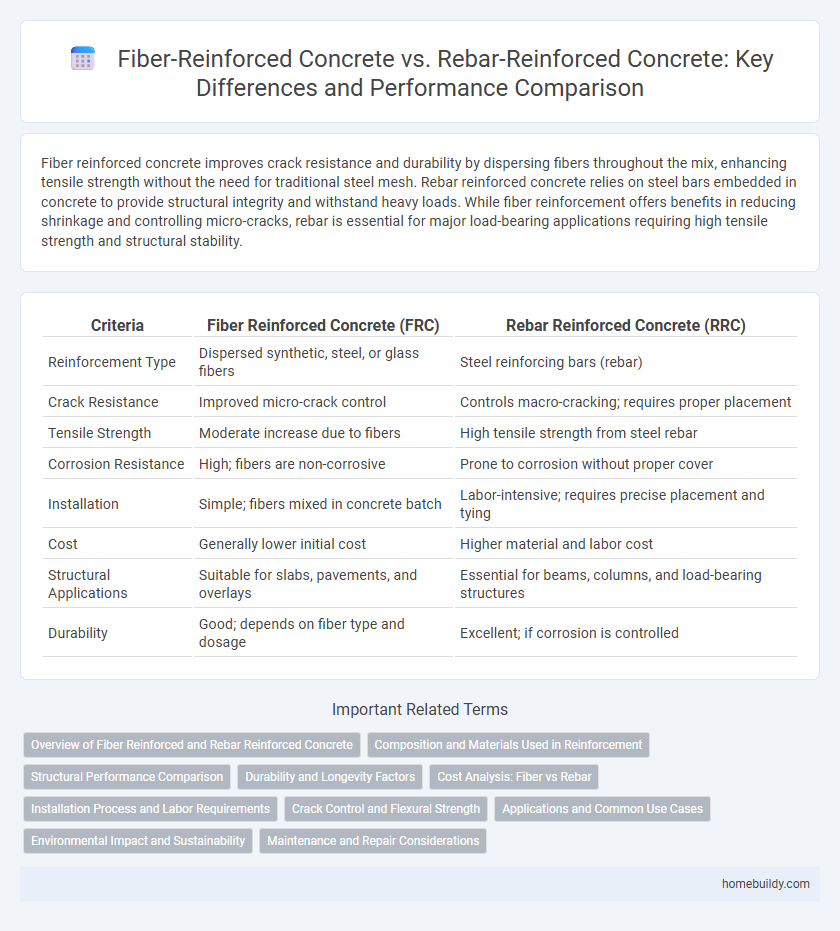Fiber reinforced concrete improves crack resistance and durability by dispersing fibers throughout the mix, enhancing tensile strength without the need for traditional steel mesh. Rebar reinforced concrete relies on steel bars embedded in concrete to provide structural integrity and withstand heavy loads. While fiber reinforcement offers benefits in reducing shrinkage and controlling micro-cracks, rebar is essential for major load-bearing applications requiring high tensile strength and structural stability.
Table of Comparison
| Criteria | Fiber Reinforced Concrete (FRC) | Rebar Reinforced Concrete (RRC) |
|---|---|---|
| Reinforcement Type | Dispersed synthetic, steel, or glass fibers | Steel reinforcing bars (rebar) |
| Crack Resistance | Improved micro-crack control | Controls macro-cracking; requires proper placement |
| Tensile Strength | Moderate increase due to fibers | High tensile strength from steel rebar |
| Corrosion Resistance | High; fibers are non-corrosive | Prone to corrosion without proper cover |
| Installation | Simple; fibers mixed in concrete batch | Labor-intensive; requires precise placement and tying |
| Cost | Generally lower initial cost | Higher material and labor cost |
| Structural Applications | Suitable for slabs, pavements, and overlays | Essential for beams, columns, and load-bearing structures |
| Durability | Good; depends on fiber type and dosage | Excellent; if corrosion is controlled |
Overview of Fiber Reinforced and Rebar Reinforced Concrete
Fiber reinforced concrete incorporates distributed fibers such as steel, glass, or synthetic materials to enhance tensile strength and crack resistance, offering improved durability and reduced maintenance costs. Rebar reinforced concrete uses steel bars embedded within the concrete to provide significant structural strength, particularly in tension zones, enabling it to support heavy loads and resist bending forces effectively. Both methods improve concrete performance, but fiber reinforcement is often preferred for controlling shrinkage cracking while rebar reinforcement is essential in high-stress structural applications.
Composition and Materials Used in Reinforcement
Fiber reinforced concrete incorporates synthetic or steel fibers distributed throughout the concrete matrix to enhance tensile strength, crack resistance, and durability. Rebar reinforced concrete uses steel bars embedded within the concrete to provide structural support and improve load-bearing capacity. The fibers in fiber reinforced concrete vary in length and type, such as polypropylene or carbon, while rebar reinforcement relies on various grades of steel rods conforming to specific standards for tensile strength.
Structural Performance Comparison
Fiber reinforced concrete (FRC) enhances tensile strength and crack resistance by distributing fibers throughout the matrix, improving impact and fatigue performance compared to traditional rebar reinforced concrete. Rebar reinforced concrete offers superior load-bearing capacity and ductility due to the steel reinforcement providing a robust skeleton for structural elements. While rebar excels in high-stress applications requiring precise load transfer, FRC optimizes durability and reduces microcracking, making it ideal for controlling shrinkage and improving toughness in structural components.
Durability and Longevity Factors
Fiber reinforced concrete enhances durability by distributing stresses uniformly and reducing crack propagation, leading to improved resistance against freeze-thaw cycles and corrosion compared to traditional rebar reinforced concrete. Rebar reinforced concrete relies heavily on steel bars for tensile strength but is susceptible to corrosion, which can compromise structural integrity over time without adequate protective measures. Fiber reinforcement also offers better impact resistance and reduces maintenance costs, thereby extending the longevity of concrete structures in harsh environmental conditions.
Cost Analysis: Fiber vs Rebar
Fiber Reinforced Concrete (FRC) often presents a lower initial material cost compared to traditional rebar reinforced concrete due to reduced labor and installation expenses. However, rebar reinforcement offers superior tensile strength and long-term durability, potentially lowering maintenance and repair costs over the structure's lifespan. Evaluating total lifecycle costs, including product longevity and performance under load, is essential for an accurate cost analysis between fiber and rebar reinforcement options.
Installation Process and Labor Requirements
Fiber reinforced concrete (FRC) offers a simplified installation process compared to rebar reinforced concrete due to the elimination of steel mesh tying and positioning. Labor requirements for FRC are generally lower since fibers are mixed uniformly into the concrete, reducing the need for skilled labor to place and secure reinforcement. Conversely, rebar reinforced concrete demands more intensive labor and precise placement to ensure structural integrity, increasing installation time and cost.
Crack Control and Flexural Strength
Fiber reinforced concrete improves crack control by distributing microcracks throughout the matrix, reducing crack width and propagation compared to traditional rebar reinforced concrete. Rebar reinforced concrete offers superior flexural strength due to the high tensile capacity of steel bars embedded within the concrete. Combining fibers with rebar can enhance both crack control and flexural strength, optimizing overall structural performance.
Applications and Common Use Cases
Fiber reinforced concrete (FRC) is commonly used in applications requiring enhanced crack resistance and durability, such as industrial floors, pavements, and tunnel linings. Rebar reinforced concrete is preferred in structural elements like beams, columns, and slabs where high tensile strength is critical for load-bearing capacity. FRC provides improved impact resistance and reduced shrinkage cracking, making it ideal for surface wear applications, while rebar reinforcement ensures structural stability in large-scale construction projects.
Environmental Impact and Sustainability
Fiber reinforced concrete (FRC) significantly reduces environmental impact compared to traditional rebar reinforced concrete by minimizing the use of steel, which is energy-intensive to produce and contributes to high carbon emissions. The incorporation of synthetic or natural fibers enhances durability and crack resistance, extending the lifespan of structures and reducing the frequency of repairs and material replacement. Sustainable fiber options, such as recycled or bio-based fibers, further lower the ecological footprint, making FRC a more eco-friendly choice in construction projects focused on long-term environmental benefits.
Maintenance and Repair Considerations
Fiber reinforced concrete reduces maintenance costs by minimizing crack formation and enhancing durability, resulting in fewer repairs compared to rebar reinforced concrete. Rebar reinforced concrete often requires periodic inspection and potential corrosion treatment to maintain structural integrity. Repairing fiber reinforced concrete is generally less labor-intensive since fibers help control microcracking, preventing larger structural damage.
Fiber Reinforced Concrete vs Rebar Reinforced Concrete Infographic

 homebuildy.com
homebuildy.com